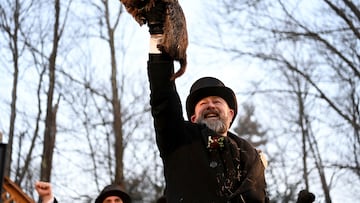When was the last time Punxsutawney Phil predicted an early spring?
Punxsutawney Phil generally gives bad news to those who desire an early end to winter weather, predicting six more weeks of cold 78% of the time.

All eyes will be on Punxsutawney, Pennsylvania come 2 February to see if “the only true weather forecasting groundhog” will foretell whether or not winter will release its grip on the United States. The National Weather Service has already predicted that this winter would be warmer than normal thanks El Niño, and Americans across much of the nation can expect above average temperatures through April according to the agency’s meteorologists.
Punxsutawney Phil will have the final word though, and according to the Punxsutawney Groundhog Club his prophecies have been correct “100% of the time.” That should worry those who are hoping for spring to be just around the corner as the four-legged, furry oracle tends to prognosticate six more weeks of winter.
In fact, over his nearly 140 years of predictions, well over three-quarters of the time he sees his shadow foreboding additional cold winter weather. Just under 15 percent of his predictions have presaged spring at the doorstep.
You may also be interested in: What is the history and origin of Groundhog Day?

When was the last time Punxsutawney Phil predicted an early spring?
A groundhog’s ability to divine the weather to come is based on whether or not he sees his shadow upon emerging from his dwelling. Clear skies bode ill for the weeks ahead as the groundhog will see his shadow and scurry back into his hovel meaning that there will be six more weeks of winter cold in store. Should the skies be cloudy, the opposite will occur, and spring will come early, at least according to superstition.
The earliest recorded mention of the western Pennsylvanian groundhog forecaster come from the Punxsutawney Spirit newspaper in 1886, which read: “up to the time of going to press, the beast has not seen its shadow.” However, the first official Groundhog Day celebration was the following year. In most cities it is a mystical groundhog that whispers into the mayor’s ear. Phil on the other hand has a whole entourage called the “Inner Circle” who decipher his prediction.
Over the last two decades, Phil has been more likely than his historical average to prognosticate an early spring. Since 2003 he hasn’t seen his shadow, predicting spring’s rapid arrival, on six occasions, or roughly 30 percent of the time. That also happens to be his percentage of accuracy at predicting what the future weather will be over the past ten years.
The most recent forecast for an early spring was in 2020, which he did happen to be correct about, with temperatures above average nationwide in February and March. The year before he made a similar prediction, but winter raged on with below average temperatures in both February and March according to the National Weather Service.
Follow all the latest news on AS USA.
